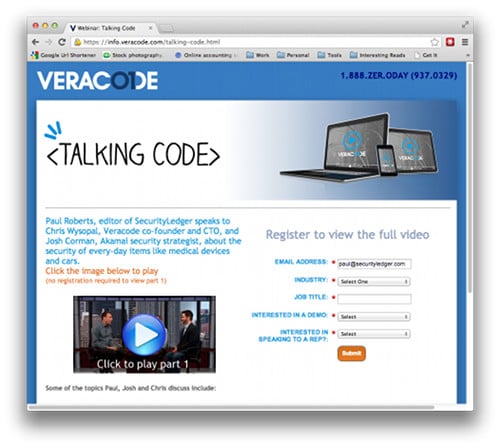One of the most vexing problems that faces IT organizations these days is how to measure their relative risk of being hacked or otherwise attacked. This sounds like pretty dry stuff, but it’s not. Failing to adequately account for your risks and exposure can mean the difference between swatting away an annoying intrusion attempt, and watching as foreign competitors or nation-states siphon off your critical intellectual property, bleeding your company of its competitiveness. But raising the alarm about this is always a tricky matter. Soft pedal it, and nobody takes you seriously. Scream from the rafters and …well…you’re screaming from the rafters. My friend and former colleague Josh Corman, however, found a good metaphor for the whole affair: the ZOMBIE APOCALYPSE. It’s all a bit of fun – though Mr. Corman is dead serious about the zombie stuff. Still, the idea is simple: attacks on your network and those of […]
Video
Beyond ‘Likes’: CrowdOptic Uses Google Glass To Map Your Focus
Sometimes a technology becomes so ubiquitous and obviously useful that we (humans) cease to think critically about its shortcomings. As an illustration of this, imagine yourself teleported back in time to the island of Manhattan in 1900. You’d find a bustling metropolis, for sure. You might look around and notice that the people dressed differently, or that the skyline was different from what we’re used to. But I bet one of the things you’d notice first was the stench emanating from the piles of horse manure and puddles of urine. As this (great) post at The Daily Kos points out, there were 200,000 horses working in New York City by 1900. Those horses were dropping 4 million pounds of manure and 40,000 gallons of urine on city streets every day. “The ubiquitous street sweepers could only pile the stuff up in vacant lots, occasionally to the height of sixty feet. To […]
Losing The Future: Schneier On How The Internet Could Kill Democracy
With his deep background in both cryptography and Internet security, Bruce Schneier is of the most thoughtful commentators on all matters cyber. So revered is he, that he even inspired a list of humorous Chuck Norris-style “Bruce Schneier” facts . In recent months, Bruce has been an invaluable sounding board amid the drip-drip-drip of details of ubiquitous government surveillance stemming from Edward Snowden’s leak of classified intelligence on NSA spying and cyber operations. In this video, from a recent speech Bruce did at the TEDxCambridge event up here in the Boston area, he goes a bit deeper: drawing out the current trend lines like hacktivism, Facebook- and Twitter-fueled popular revolutions, civil war and mass surveillance, and trying to discern what the future might look like. /div> Bruce’s theory: although nimble groups of activists, dissidents and hackers have been more adept at using the Internet and innovative technologies and platforms built on […]
Software Safety Should Be Treated Just Like Food Safety. Discuss.
It’s easy to agree with statements like “the food we buy in supermarkets should be safe to eat.” After all, who wants go to bat for shoddy growers pushing contaminated lettuce, or distributors sending out botulinum-laced fish and meats? But what about software safety? Suffice it to say that if people ate software applications instead of, say, cinnamon rolls, they’d be dropping like flies. That’s because the code that powers those applications is often riddled with potentially dangerous insecurities. Unlike the food industry, however, there have been only fitful efforts by government and industry to address what everyone recognizes is a widespread problem. I’ve written elsewhere about the relative lack of a “safety culture” in the software industry compared with industries like civil aviation or even food. (Remember: most of the food recalls and alerts that are issued today are voluntary.) But there’s also a decades-long track record of the government taking […]
Protecting Smart Cars And The Supply Chain From Hackers
One theme that frequently comes up in my conversations with experienced security veterans when we talk about security and “the Internet of Things” is the absence of what might be termed a “security culture.” That’s a hard term to define, but it basically describes a kind of organizational culture that anticipates and guards against online attacks. Certainly companies that have been selling software in any great number for any amount of time have had to develop their own security cultures – think about Microsoft’s transformation following Bill Gates Trustworthy Computing memo, or Adobe’s more recent about-face on product and software security. But that culture is lacking at many of the companies that have traditionally thought of themselves as ‘manufacturers’ – makers of “stuff,” but which now find themselves in the software business. Think General Electric (GE) or – even better – auto makers. A couple of months back, I had […]




